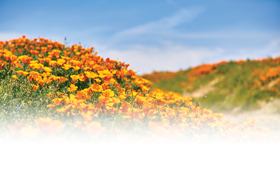Fact or Myth? Plucking the California Poppy
 Ask just about any Californian about picking the state flower—the California poppy—and you’re sure to get the same reaction: “It’s illegal!” But is it?
Ask just about any Californian about picking the state flower—the California poppy—and you’re sure to get the same reaction: “It’s illegal!” But is it?
According to the California Department of Fish and Wildlife, there is no law protecting the California poppy specifically. However, California Penal Code Section 384a requires written landowner permission to remove and sell plant material from land that a person does not own. The removal of such plants without permission may constitute as trespassing or petty theft and a possible fine of up to $1,000. So, if you’re going to pick a poppy, don’t worry about Johnny Law coming after you. Just keep in mind that they last much longer in the ground than when plucked.
Smart Landscapes
A well-maintained yard is like any beautiful accessory—it shines. But how can a home have curb appeal and lush landscaping during a drought or a fire season? Fear not; fire-safe landscaping is not as expensive as you think, and may increase your property value. And low-water consuming plants and options are easily available and could benefit your pocket book in the long run. Local tree farms like Urban Tree Farm in Santa Rosa provide lists of available fire resistant and drought friendly plants and trees on their website.
Fire resistant landscaping.
More than 1,445 structures are destroyed each year in California by wildfire. According to readyforwildfire.org, you can create fire safe zones with stonewalls, patios, decks and roadways. Firebreaks can be made using rock, mulch and flower beds as ground cover. Certain plant species such as rockrose, ice plant and aloe are fire retardant and may resist ignition. If you’re planting trees, maple, poplar and cherry are less flammable than pine, fir and conifers.
Drought resistant landscaping.
In California, the Mediterranean climate brings dry summers and rainy winters. There are many native California plants that are perfect for California’s climate and may save more water than others. These include: agave species, sage, rosemary, California lilac, buffalo-grass and swan hill olive trees.
www.calwater.com
Arranging Vegetation
 Like a ladder, fire climbs neighboring trees, also known as vertical fuel continuity or “ladder” fuels. To reduce the chance of fire, create a home defense zone and remove lower tree limbs six to 15 feet from the ground. From a horizontal standpoint, fire spreads on the ground from plant-to-plant and eventually to your home. Increase spacing between plants to reduce the chance of fire making its way to your house. Here’s five ways to enhance your home defense zone:
Like a ladder, fire climbs neighboring trees, also known as vertical fuel continuity or “ladder” fuels. To reduce the chance of fire, create a home defense zone and remove lower tree limbs six to 15 feet from the ground. From a horizontal standpoint, fire spreads on the ground from plant-to-plant and eventually to your home. Increase spacing between plants to reduce the chance of fire making its way to your house. Here’s five ways to enhance your home defense zone:
•Maintain high moisture content in vegetation.
•Increase space between plants, which decreases plant-fuel density.
•Shorten the height of plants.
•Be sure to create spacing between plants and your home.
•Remove any combustible materials such as: firewood, twigs, leaves and cardboard boxes.
Author
-

Bill Meagher is a contributing editor at NorthBay biz magazine. He is also a senior editor for The Deal, a Manhattan-based digital financial news outlet where he covers alternative investment, micro and smallcap equity finance, and the intersection of cannabis and institutional investment. He also does investigative reporting. He can be reached with news tips and legal threats at bmeagher@northbaybiz.com.
View all posts



